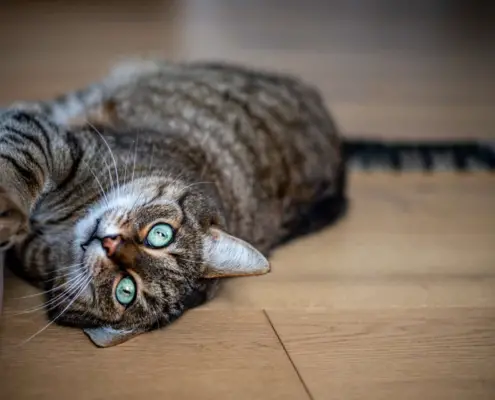
Cats are renowned for their agility, grace, and athletic abilities. Behind these extraordinary feats lies a complex and remarkable muscular system that enables them to pounce, jump, and climb with ease. Understanding a cat’s muscular system is not only fascinating but also crucial for their overall health and well-being. In this article, we will explore the various aspects of a cat’s muscular system, from its anatomy and function to common issues and ways to keep it healthy.
The Importance of a Strong Muscular System for Cats
A strong muscular system is essential for cats to perform their natural behaviors effectively. Whether it’s chasing prey, leaping onto high surfaces, or engaging in play, a cat relies on its muscles for every movement. The muscles provide the power and strength required for these activities, ensuring that a cat can navigate its environment with precision and efficiency. A well-developed muscular system also contributes to a cat’s balance and coordination, enabling it to land gracefully on its feet after a jump or fall. Therefore, maintaining a healthy muscular system is vital for a cat’s overall quality of life.
Anatomy of a Cat’s Muscles
To better understand a cat’s muscular system, let’s delve into its anatomy. A cat’s body is composed of over 500 individual muscles, each with its own unique structure and function. These muscles are distributed throughout the body, from the head to the tail, and are responsible for various movements and actions. At a microscopic level, muscles are made up of long, slender cells called muscle fibers. These fibers contain proteins called actin and myosin, which slide past each other to create the contractions that generate movement. The arrangement and organization of these muscle fibers give cats their incredible strength and agility.
Types of Muscles in a Cat’s Body
Cats have three main types of muscles: skeletal muscles, smooth muscles, and cardiac muscles. Skeletal muscles are attached to the bones and are responsible for voluntary movements, such as walking and jumping. Smooth muscles are found in the digestive system, blood vessels, and other internal organs, and they control involuntary actions like digestion and blood circulation. Lastly, cardiac muscles are exclusively found in the heart and ensure its continuous rhythmic contractions, allowing for efficient pumping of blood throughout the body. Each type of muscle plays a crucial role in a cat’s overall function and well-being.
How a Cat’s Muscles Work Together
A cat’s muscles work together in a synchronized manner to produce fluid and precise movements. When a cat wants to pounce on its prey, for example, a series of intricate muscle contractions and relaxations occur. The muscles in its legs and back gather tension, preparing for the explosive force needed to propel itself forward. As the cat lunges forward, the muscles contract, providing the necessary power and propulsion. Simultaneously, the muscles in its jaw, neck, and forelimbs coordinate to ensure a successful capture. This coordination of various muscle groups allows cats to exhibit their incredible athleticism and agility.
Common Muscular Issues in Cats
Just like humans, cats can experience muscular issues that affect their mobility and overall well-being. One common problem is muscle sprains and strains, which can occur due to overexertion, trauma, or sudden movements. These injuries can cause pain, stiffness, and limping. Another condition is muscle atrophy, which is the wasting or loss of muscle mass. This can happen due to aging, lack of physical activity, or underlying health issues. Muscle atrophy can result in weakness, reduced mobility, and a decreased quality of life for cats. It’s important for cat owners to be aware of these issues and seek veterinary care promptly if any concerns arise.
Tips for Keeping a Cat’s Muscular System Healthy
Maintaining a healthy muscular system is essential for a cat’s overall well-being. Here are some tips to help keep your feline friend’s muscles in top condition:
- Regular exercise: Engage your cat in interactive play sessions to promote muscle strength and flexibility. Activities like chasing toys, climbing cat trees, and using puzzle feeders can provide mental and physical stimulation.
- Provide scratching surfaces: Scratching is a natural behavior for cats that helps them stretch their muscles and maintain healthy nails. Offer scratching posts or boards to encourage this activity and prevent muscle stiffness.
- Monitor weight and diet: Obesity can strain a cat’s muscles and joints, leading to various health issues. Ensure your cat maintains a healthy weight through a balanced diet and portion control. Consult with your veterinarian to determine the appropriate nutritional needs for your cat’s age and activity level.
- Regular veterinary check-ups: Routine veterinary examinations can help identify any muscular issues early on. Your veterinarian can assess your cat’s muscle tone, flexibility, and overall condition, providing appropriate guidance for maintaining optimal muscular health.
Exercises to Strengthen a Cat’s Muscles
In addition to regular exercise and play, specific exercises can target and strengthen different muscle groups in cats. Here are a few exercises that can help improve your cat’s muscular health:
- Hind leg lifts: Gently lift one of your cat’s hind legs and hold it for a few seconds before releasing. Repeat this exercise with the other leg. This exercise helps strengthen the muscles in the hind limbs and improves balance.
- Jumping exercises: Encourage your cat to jump onto elevated surfaces, such as cat trees or shelves. Start with lower heights and gradually increase the difficulty. Jumping exercises engage the muscles in the legs and core, promoting strength and agility.
- Paw squeezes: Gently apply pressure to your cat’s paw pads, causing the muscles in their legs to contract. Hold for a few seconds and release. Repeat this exercise with each paw. Paw squeezes help strengthen the muscles in the legs and paws.
Understanding the Role of Nutrition in a Cat’s Muscular Health
Proper nutrition is crucial for maintaining a cat’s muscular health. A diet rich in high-quality protein is essential, as it provides the necessary amino acids for muscle growth and repair. Look for cat food that lists a named animal protein, such as chicken or fish, as the first ingredient. Additionally, ensure that the diet is well-balanced and meets all of your cat’s nutritional requirements. Consult with your veterinarian to determine the best diet plan for your cat’s specific needs.
Appreciating the Marvel of a Cat’s Muscular System
The muscular system of a cat is a marvel of nature, allowing these graceful creatures to perform incredible feats of athleticism. Understanding the anatomy, function, and care of a cat’s muscles is vital for providing them with a healthy and fulfilling life. By incorporating regular exercise, monitoring their diet, and seeking veterinary care when needed, you can ensure that your feline companion enjoys strong and agile muscles throughout their lives. Take the time to appreciate the beauty and power of a cat’s muscular system, and your bond with your furry friend will undoubtedly grow stronger.
If you enjoyed my article, I would appreciate you sharing it with your network.

Sima Ndlebe
Sima writes for CatBuzz. He is interested in Cats, Health and Fitness, and Entrepreneurship.
Published: 31 October 2023




